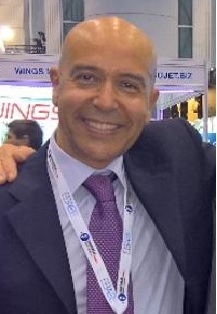Reshaped U.S.-Europe Relationship Defines Paris Air Show
Details
More Products & Services
Products & Services
Home - Aviation Group Marketing
Aviation Week Network
120 data points on over 156,000 commercial and business aviation aircraft, including military transports. Discover the most trustworthy resource for the complete aircraft history, plus ad hoc reports, month-over-month trend analysis and details on expected deliveries through 2050.
Aerospace | Aviation Week Network
Aviation Week Network
https://aviationweek.com/themes/custom/particle/dist/app-drupal/assets/awn-logo.svg
People

Andrea Rossi Prudente
Aviation Week Network

Anthony Lim
Aviation Week Network
Sales director

Becca Balmes
Aviation Week Network

Belinda Tan
Aviation Week Network

Brian Everstine
Aviation Week Network
Editor

Eddie Krankowski
Aviation Week Network
Assistant Manager, Tradeshows

erving dockery
Aviation Week Network

Lisa Tan
Aviation Week Network
Senior Marketing Manager

Mark Thomas
Aviation Week Network
Description
Aviation has shaped—and been shaped by—change since before the Wright brothers flew at Kitty Hawk or Louis Blériot crossed the English Channel. But the velocity, complexity and turbulence of change has reached new levels, challenging the aerospace industry's ability to adapt.
Hot wars, cold wars and trade wars. Climate change and supply chains. The aerospace industry finds itself at a nexus of forces not felt in recent history. Military alliances are being tested and sustainability targets questioned as fundamental differences between Europe and the U.S. come into sharp focus.Trump administration scrutinizes commercial supply chainsEurope works to promote innovation in defense and spaceEU and U.S. paths on sustainability continue to diverge
As the Paris Air Show opens, attention is on the widening Atlantic divide and the possibly of a distancing—perhaps even a decoupling—of aerospace and defense ecosystems. The show takes place as the U.S. and European Union strive to reach an agreement on a trade deal before President Donald Trump's July 9 deadline to impose punitive 50% tariffs on EU goods.
The aerospace gathering is also occurring on the eve of a NATO summit and a decision to increase the alliance's defense spending target to 5% of GDP. Under intense pressure from Trump to carry a higher burden for their own defense, more European nations have moved to meet the current 2% target, and industry on both sides of the Atlantic is already seeing the payoff.
Having already embroiled aerospace in its tariff fights, the Trump administration is taking aim at the global supply chain on which the industry is built. The U.S. Commerce Department launched an investigation in May to determine whether the import of commercial aircraft, engines and parts is a threat to national security. Scheduled to be completed by January, the investigation was initiated under Section 232 of the Trade Expansion Act of 1962, which empowers the president to restrict imports if they are found to threaten to impair U.S. national security. Trump has used Section 232 to justify imposing tariffs on other industries, from steel to trucks.
The investigation seeks to determine the extent to which U.S. domestic production of commercial aircraft and engines can meet expected domestic demand and to understand the role of foreign supply chains in meeting that demand as well as the potential for foreign nations to “weaponize” their control over those supplies.
Industry lobby group the Business Roundtable asserts that conditions previously used to justify tariffs under Section 232 are not present in the commercial aerospace industry, where supply chains are aligned with U.S. interests, exports are strictly controlled, and manufacturing operations in the U.S. ensure high domestic content.
But the Aerospace Industries Association (AIA) has encouraged the Trump administration to use the Section 232 investigation to address existing trade barriers, encourage foreign investment in U.S. industry and secure preferential trade terms. The AIA cites the deal struck with the UK in March, which includes an exemption from Section 232 tariffs for aircraft engines and parts.
The global air transport industry held steady to its net-zero 2050 goal at the International Air Transport Association Annual General Meeting in New Delhi in June, despite public comments from many airline leaders that the target is unachievable given the current trajectory of sustainable aviation fuel (SAF) production volumes and costs.
But government commitments to sustainability remain very different on either side of the Atlantic. The EU says its SAF mandates are here to stay, despite deep concerns among European airlines that the legislation is failing to create the affordable SAF market it promised. Fuel suppliers are not delivering, they say, and without urgent action, the credibility of the mandate will be severely undermined.
The U.S. and EU took opposing approaches to stimulating SAF production, Washington favoring the carrot of a tax break over the stick of Brussels' mandate. While the U.S. approach was threatened by the climate-skeptical Trump administration's opposition to green energy, the massive spending bill now before Congress continues the SAF tax break, although the bill itself faces strong opposition.
Any sort of stick is unlikely to be wielded over SAF producers in the U.S., but the EU is planning a carrot to back up its mandate in the form of the Sustainable Transport Investment Plan (STIP). Set to be released this year, the plan is expected to provide specific EU funds to support production of renewable fuels, particularly the power-to-liquid e-fuels favored over biofuels in Europe. The region's airlines describe STIP as the EU's chance to make or break its SAF mandates.
Trump's antipathy to green technology includes plans for deep cuts in NASA's aeronautics research budget. These include ending the X-66 Sustainable Flight Demonstrator and Electrified Propulsion Flight Demonstration programs. Boeing and NASA will conduct a ground demonstration of thin-wing technology for the next single-aisle aircraft, but work on next-generation turbine engines will be delayed and rescoped.
Europe is not without its own abrupt shifts on sustainability. Decisions by Airbus and ATR to delay development of hydrogen-electric and hybrid-electric airliners, respectively, threw a spanner in the works of the EU's Clean Aviation research program, which was planning flight demonstrations for both powertrains by the end of the decade. Clean Aviation is still hoping to resurrect a hybrid flight demonstrator.
Compared with the U.S., Europe's innovation ecosystem continues to underperform in investment and outcomes. This was underlined late in 2024, when the region's leading electric vertical-takeoff-and-landing (eVTOL) startups both filed for insolvency after German federal and state governments declined to provide loan guarantees that would have unlocked much-needed additional private investment.
Volocopter was acquired in March by China's Wanfeng through its Austrian subsidiary Diamond Aircraft, but Lilium was forced back into insolvency when a rescue deal fell through. Europe lost its lead in eVTOL. And this despite a European regulator that led in creating the first airworthiness specifications for eVTOLs in 2019, while the FAA wrong-footed industry in 2021 by changing course on type certification.
But in the U.S., advanced air mobility startups have found it easier to tap into sources of nondilutive government funding. Investor interest has pivoted sharply away from electric aviation toward space and defense, however, and Europe has moved to put in place funding mechanisms to encourage innovation in sectors it considers far more strategic to the autonomy and security of the EU.
The U.S. has steered hundreds of millions of dollars toward small startups through the Pentagon's Defense Innovation Unit as well as the Air Force AFWerx and Space Force SpaceWERX organizations. Although falling well short of the sought-after procurement funding for programs of record, this support has proved useful in attracting investors keen to break into defense and space.
Europe and NATO are taking a page from the same book and have established various innovation funds in a bid to foster defense and space startups. Part of the EU's €800 billion ($910 billion) ReArm Europe plan is to widen European Investment Bank lending to defense and security projects and accelerate the Savings and Investment Union to mobilize private capital in support of small and midsize companies.
Many European startups in aviation, defense and space will be present at this year's Paris Air Show. Whether the EU can create a lasting aerospace and defense innovation ecosystem to rival the U.S. remains to be seen. Europe may hope to mimic the meteoric rise of such new U.S. players as SpaceX and Anduril, but it remains fragmented in government spending and industrial organization.
Hot wars, cold wars and trade wars. Climate change and supply chains. The aerospace industry finds itself at a nexus of forces not felt in recent history. Military alliances are being tested and sustainability targets questioned as fundamental differences between Europe and the U.S. come into sharp focus.Trump administration scrutinizes commercial supply chainsEurope works to promote innovation in defense and spaceEU and U.S. paths on sustainability continue to diverge
As the Paris Air Show opens, attention is on the widening Atlantic divide and the possibly of a distancing—perhaps even a decoupling—of aerospace and defense ecosystems. The show takes place as the U.S. and European Union strive to reach an agreement on a trade deal before President Donald Trump's July 9 deadline to impose punitive 50% tariffs on EU goods.
The aerospace gathering is also occurring on the eve of a NATO summit and a decision to increase the alliance's defense spending target to 5% of GDP. Under intense pressure from Trump to carry a higher burden for their own defense, more European nations have moved to meet the current 2% target, and industry on both sides of the Atlantic is already seeing the payoff.
Having already embroiled aerospace in its tariff fights, the Trump administration is taking aim at the global supply chain on which the industry is built. The U.S. Commerce Department launched an investigation in May to determine whether the import of commercial aircraft, engines and parts is a threat to national security. Scheduled to be completed by January, the investigation was initiated under Section 232 of the Trade Expansion Act of 1962, which empowers the president to restrict imports if they are found to threaten to impair U.S. national security. Trump has used Section 232 to justify imposing tariffs on other industries, from steel to trucks.
The investigation seeks to determine the extent to which U.S. domestic production of commercial aircraft and engines can meet expected domestic demand and to understand the role of foreign supply chains in meeting that demand as well as the potential for foreign nations to “weaponize” their control over those supplies.
Industry lobby group the Business Roundtable asserts that conditions previously used to justify tariffs under Section 232 are not present in the commercial aerospace industry, where supply chains are aligned with U.S. interests, exports are strictly controlled, and manufacturing operations in the U.S. ensure high domestic content.
But the Aerospace Industries Association (AIA) has encouraged the Trump administration to use the Section 232 investigation to address existing trade barriers, encourage foreign investment in U.S. industry and secure preferential trade terms. The AIA cites the deal struck with the UK in March, which includes an exemption from Section 232 tariffs for aircraft engines and parts.
The global air transport industry held steady to its net-zero 2050 goal at the International Air Transport Association Annual General Meeting in New Delhi in June, despite public comments from many airline leaders that the target is unachievable given the current trajectory of sustainable aviation fuel (SAF) production volumes and costs.
But government commitments to sustainability remain very different on either side of the Atlantic. The EU says its SAF mandates are here to stay, despite deep concerns among European airlines that the legislation is failing to create the affordable SAF market it promised. Fuel suppliers are not delivering, they say, and without urgent action, the credibility of the mandate will be severely undermined.
The U.S. and EU took opposing approaches to stimulating SAF production, Washington favoring the carrot of a tax break over the stick of Brussels' mandate. While the U.S. approach was threatened by the climate-skeptical Trump administration's opposition to green energy, the massive spending bill now before Congress continues the SAF tax break, although the bill itself faces strong opposition.
Any sort of stick is unlikely to be wielded over SAF producers in the U.S., but the EU is planning a carrot to back up its mandate in the form of the Sustainable Transport Investment Plan (STIP). Set to be released this year, the plan is expected to provide specific EU funds to support production of renewable fuels, particularly the power-to-liquid e-fuels favored over biofuels in Europe. The region's airlines describe STIP as the EU's chance to make or break its SAF mandates.
Trump's antipathy to green technology includes plans for deep cuts in NASA's aeronautics research budget. These include ending the X-66 Sustainable Flight Demonstrator and Electrified Propulsion Flight Demonstration programs. Boeing and NASA will conduct a ground demonstration of thin-wing technology for the next single-aisle aircraft, but work on next-generation turbine engines will be delayed and rescoped.
Europe is not without its own abrupt shifts on sustainability. Decisions by Airbus and ATR to delay development of hydrogen-electric and hybrid-electric airliners, respectively, threw a spanner in the works of the EU's Clean Aviation research program, which was planning flight demonstrations for both powertrains by the end of the decade. Clean Aviation is still hoping to resurrect a hybrid flight demonstrator.
Compared with the U.S., Europe's innovation ecosystem continues to underperform in investment and outcomes. This was underlined late in 2024, when the region's leading electric vertical-takeoff-and-landing (eVTOL) startups both filed for insolvency after German federal and state governments declined to provide loan guarantees that would have unlocked much-needed additional private investment.
Volocopter was acquired in March by China's Wanfeng through its Austrian subsidiary Diamond Aircraft, but Lilium was forced back into insolvency when a rescue deal fell through. Europe lost its lead in eVTOL. And this despite a European regulator that led in creating the first airworthiness specifications for eVTOLs in 2019, while the FAA wrong-footed industry in 2021 by changing course on type certification.
But in the U.S., advanced air mobility startups have found it easier to tap into sources of nondilutive government funding. Investor interest has pivoted sharply away from electric aviation toward space and defense, however, and Europe has moved to put in place funding mechanisms to encourage innovation in sectors it considers far more strategic to the autonomy and security of the EU.
The U.S. has steered hundreds of millions of dollars toward small startups through the Pentagon's Defense Innovation Unit as well as the Air Force AFWerx and Space Force SpaceWERX organizations. Although falling well short of the sought-after procurement funding for programs of record, this support has proved useful in attracting investors keen to break into defense and space.
Europe and NATO are taking a page from the same book and have established various innovation funds in a bid to foster defense and space startups. Part of the EU's €800 billion ($910 billion) ReArm Europe plan is to widen European Investment Bank lending to defense and security projects and accelerate the Savings and Investment Union to mobilize private capital in support of small and midsize companies.
Many European startups in aviation, defense and space will be present at this year's Paris Air Show. Whether the EU can create a lasting aerospace and defense innovation ecosystem to rival the U.S. remains to be seen. Europe may hope to mimic the meteoric rise of such new U.S. players as SpaceX and Anduril, but it remains fragmented in government spending and industrial organization.

Share
Recent Chats
Share via email
Future: handle WhatsApp here
Future: handle LinkedIn here
Future: handle Twitter here
SUBMENU HERE
Share via Chat
Copy Link

